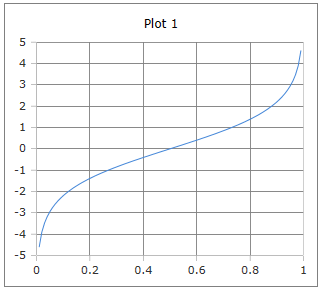Logit Function
Online calculator and formulas for the Logit function - inverse function of the Sigmoid function for Machine Learning
Logit Function Calculator
Logit (Log-Odds) Function
The logit(p) or Log-Odds function is the inverse function of the Sigmoid function and central in Machine Learning.
Logit Function Curve

Logit Function Curve: The function maps probabilities (0,1) to real numbers (-∞,+∞).
Properties: Strictly monotonically increasing, symmetric around (0.5, 0).
|
|
Logit Function Formulas
Basic Formula
Logarithm of the odds (odds ratio)
Alternative Form
Equivalent representation
Arctanh Form
Hyperbolic representation
Inverse Function
Sigmoid as inverse of the Logit function
Logistic Regression
Linear combination of predictors in logit space
Properties
Special Values
Domain
Open between 0 and 1 (exclusive)
Range
All real numbers
Application
Machine Learning, logistic regression, statistics and data analysis.
What are Odds (Odds Ratio)?
Odds describe the ratio of the probability for an event to the probability against the event:
Example: With a probability of 75% (p = 0.75):
- Odds = 0.75 / 0.25 = 3
- Interpretation: "3 to 1" or "3:1"
- Log-Odds = ln(3) ≈ 1.099
Advantages of Log-Odds:
- Symmetric around 0
- Unlimited range
- Linear in regression models
Detailed Description of the Logit Function
Mathematical Definition
The Logit function is the inverse function of the Sigmoid function and transforms probabilities (0,1) into the entire real number range (-∞,+∞). It is the heart of logistic regression and many Machine Learning algorithms.
Using the Calculator
Enter a probability between 0 and 1 (exclusive) and click 'Calculate'. The function is not defined for p = 0 or p = 1.
Historical Background
The Logit function was introduced in the 1940s by Joseph Berkson as an alternative to probit analysis. The name "Logit" is a contraction of "Logistic Unit" and quickly became the standard in statistics.
Properties and Applications
Machine Learning Applications
- Logistic regression (binary classification)
- Neural networks (activation function)
- Generalized linear models (GLM)
- Bayesian statistics and MCMC
Statistical Applications
- Epidemiology (disease risk)
- Econometrics (voting behavior)
- Psychometrics (Item Response Theory)
- Bioinformatics (gene expression)
Special Properties
- Monotonicity: Strictly monotonically increasing
- Symmetry: logit(p) = -logit(1-p)
- Linearity: Enables linear modeling
- Interpretability: Coefficients as log-odds
Interesting Facts
- The Logit function is the canonical link function for the binomial distribution
- It transforms bounded probabilities into unbounded log-odds
- Central to maximum likelihood estimation in logistic regression
- Related to the logistic growth model in population dynamics
Calculation Examples
Example 1
logit(0.5) = 0
Neutral probability → Log-Odds = 0
Example 2
logit(0.75) ≈ 1.099
75% probability → Odds 3:1
Example 3
logit(0.25) ≈ -1.099
25% probability → Odds 1:3
Logistic Regression
Model Equation
In logistic regression, the logit transformation is used:
This enables linear modeling of probabilities.
Interpretation
The coefficients βᵢ have a clear interpretation:
- exp(βᵢ): Odds Ratio
- βᵢ > 0: Increases the odds
- βᵢ < 0: Decreases the odds
- βᵢ = 0: No effect
|
|
|
|